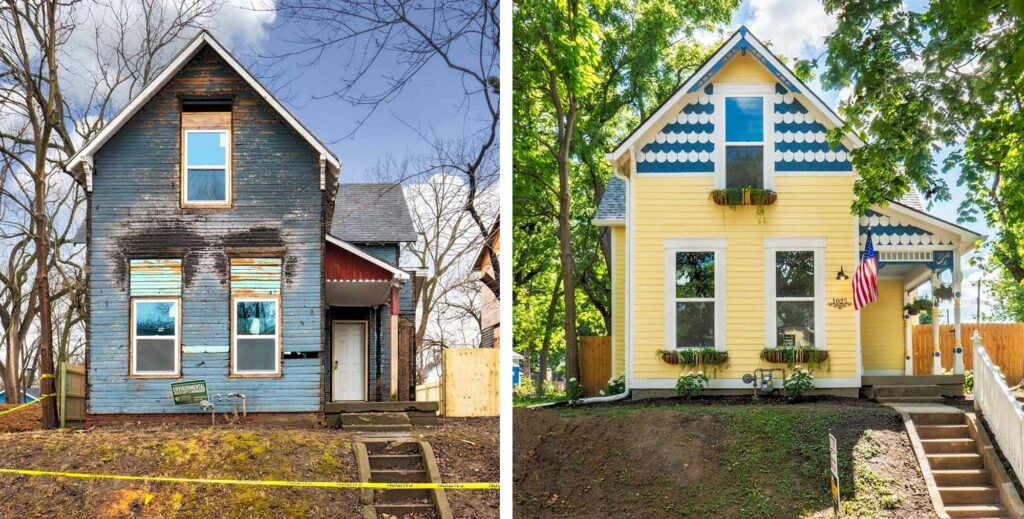“Flippers” of Residential Properties Must Disclose Additions, Structural Modifications, Repairs and Renovations to the Property that are Resold within 18 Months of Closing
Who is a flipper?
Real estate speculation, commonly known as house flipping, entails the strategic acquisition of a real property with the intent of a brief ownership period, followed by its resale at an elevated value (after you improve or just hold the property for a short amount of time). In contrast to acquiring a residence for personal habitation, this practice involves treating real estate as an investment vehicle, akin to the speculative approach applied to stocks.

If you flip residential properties, or you represent flippers when they sell there are new disclosure requirements that apply directly to you. Honestly, before this statute became law these minimal disclosures for flippers should have been made anyway, but now they are codified.
This new statute applies to real property transactions if:
- It is a residential property with 1 to 4 units.
- Seller accepts an offer within 18 months from the date that the seller took title to the transferred property and
- Renovations or repairs were performed by a contractor with whom the seller entered into a contract.
Requires the flipping seller to disclose to the prospective buyer:
- Any room additions
- Any structural modifications
- Other alterations
- Repairs
- A copy of any permits if obtained
(or if the seller contracted with a third party and was not provided with a copy of any permits, the seller may inform the buyer that the permits may be obtained through the third party and provide their contact information).
These disclosures may alternatively be disclosed as a list as given by the contractor to the seller.
Additionally, where the cost of labor and materials was $500 or greater, the seller will disclose.
- The name of each contractor.
- The contact information of each contractor (as provided to the seller).
Importantly, if a seller, by himself or herself, performs an addition, structural modification, or alteration under an Owner-Builder California Civil Code Section 7044 they too would be required to disclose such information to a prospective purchaser under the materiality disclosure requirement of California Civil Code 1102 et. seq.
This new flipper disclosure requirement comes within the framework of the Real Estate Transfer Disclosure Statement law of 1102 et. seq. It is applicable under identical conditions as the TDS, sharing equivalent exemptions and being subject to analogous cancellation rights as those pertaining to the TDS and associated disclosures.
This law enacted as California Civil Code § 1102.6h. will be effective after July 1, 2024.
Local Agencies May Adopt Ordinances to Allow the Separate Conveyance of an Accessory Dwelling Unit (ADU) as a Condominium from the Primary Residence
This new law, codified as California Government Code §§ 75852.2 and 75852.25, allows local agencies, cities, and counties to adopt ordinances to allow the separate conveyance of ADUs and primary residences as condominiums. The new ordinances, adopted by each participating jurisdiction, must require that the process to complies with both the Davis-Stirling Common Interest Development Act, which governs homeowners’ associations (HOAs), and the Subdivision Map Act, which controls the subdivision of property.
If a property is within a homeowner’s association, that homeowners’ association must approve the creation of the condominium. The new law requires that there be written and recorded evidence that each lienholder consents to the establishment of the condominiums.

What does this really mean for homeowners with ADUs? If you have an ADU or build one in the future, you can apply to have that ADU designated as a condominium and sell that ADU as a condominium to purchaser. California real estate is extremely expensive, but with the implementation of SB9 and this new law California is making headway to get more people in homes for less money.
This new law is effective January 1, 2024.
Big Time Landlord’s Upfront Security Deposit Collection Abilities are Curtailed
Sophisticated multiple property landlords are being handcuffed again by the California legislature. Beginning July 1, 2024, this new law (which is modifying CA Civil Code 1950 et. seq.) prohibits a multi-property landlord from demanding or receiving security deposit for a residential rental property in an amount or value more than an amount equal to one month’s rent, regardless of whether the residential property is unfurnished or furnished. This security deposit is in addition to any rent for the first month paid on or before initial start date of the tenancy.
Mom & Pop Landlords Excepted: A small landlord (mom and pop) may receive a security deposit in an amount or value not more than 2 months’ rent, whether the unit is furnished, in addition to any rent for the first month. A small landlord (mom and pop) is defined as a landlord (1) that is a natural person or a limited liability corporation in which all members are natural persons and (2) owns no more than two residential rental properties that collectively include no more than four dwelling units offered for rent. This exception for mom-and-pop landlords includes family trusts.
This mom-and-pop landlord exception does not apply if the prospective tenant is a service member.
All landlords, whether they are corporate or mom and pop, who currently hold a tenants’ security deposit prior to July 1, 2024, may continue to retain the security deposit even if it is more than one month’s rent.
As a reminder, a security deposit is the tenant’s monies held in trust for the benefit of damages caused by the tenant to the real property.
Tenant Protection Act (TPA) Modified to Make it More Difficult Terminate a Tenancy – And Landlords Who Violate TPA Can Be Liable for Actual Damages and Attorney’s Fees
Effective April 1, 2023, the California Tenant Protection Act of 2019 which is a statewide rent cap and just cause eviction law for certain properties, is modified to further protect tenants. Pursuant to the TPA, only four circumstances allow a landlord to a basis for no-fault termination of tenancy. Modifications will now close two loopholes: terminations based on an owner move-in and those based on substantial remodeling. The new provisions also address remedies for violations. The existing TPA statute does not specify damages nor enforcement mechanisms.

Changes to Termination of Tenancy Due to Owner Move-In:
Under new provisions to lawfully evict a tenant for just cause based on an owner move-in:
- Owner/landlord must identify in writing the name and relationship to the owner of the intended occupant and include Notice that the tenant can request proof that intended occupant is actually an owner or related to the owner.
- Owner/landlord or their intended family member must move in within 90 days after the evicted tenant vacates and then occupy the rental unit for at least one year.
- Owner/landlord or their intended relative cannot already occupy a unit at that property and there could not be another vacant unit at that same property.
- if the intended relative does not actually move in within 90 days or use the unit as their primary residence for at least a year, the owner is required offer the unit back to the evicted tenant at the same lease terms in effect at the time they vacated and reimburse the tenant for reasonable moving expenses incurred in excess of the required relocation assistance payment that may have been made in connection with the eviction.
- if evicted tenant does not move back in, and the owner subsequently identifies a new tenant still within the yearlong period after the eviction, the unit must continue to be offered at the lawful rent in effect at the time the eviction occurred and
- owner must be a natural person holding at least a 25% ownership interest in the property (to prevent someone who holds a very small share of the property from evicting a tenant)
Termination Based on Intent to Demolish or Substantially Remodel the Rental Property
Effective April 1, 2023, the California Tenant Protection Act of 2019 is modified to further protect tenants when evicted based on a Landlord’s claim that they are substantially remodeling the rental unit.
Remodeling must require the tenant to vacate for 30 Consecutive Days. The remodel must legitimately not be able to be accomplished in a safe manner that allows the tenant to remain living in the place and must require the tenant to vacate the property for at least thirty consecutive days.
However, the tenant is not required to vacate the property on any days where a tenant could continue living in the property without violating health, safety, and habitability codes and laws.
Written Notice
A written notice terminating a tenancy must include all the following:
A statement informing tenants of the intent to demolish or substantially remodel the unit, including the following statement which is required verbatim:
“If the substantial remodel of your unit or demolition of the property as described in this notice of termination is not commenced or completed, the owner must offer you the opportunity to re-rent your unit with a rental agreement containing the same terms as your most recent rental agreement with the owner at the rental rate that was in effect at the time you vacated. You must notify the owner within 30 days of receipt of the offer to re-rent of your acceptance or rejection of the offer, and, if accepted, you must reoccupy the unit within 30 days of notifying the owner of your acceptance of the offer”,
A detailed and thorough description of the substantial remodel to be completed, the approximate expected duration of the substantial remodel, or, if the property is to be demolished, the expected date by which the property will be demolished,
A copy of the permit or permits required to undertake the substantial remodel. However, if the renovation is to abate hazardous materials, then no permit need be given unless legally required by the authority having jurisdiction.
A notification that if the tenant is interested in reoccupying the rental unit following the substantial remodel, the tenant must inform the owner of their interest and provide to the owner their address, telephone number, and email address.
New Modifications Now Provides Any Termination Notice that Does Not Comply with Any Provision of the TPA Just Cause Rules is Void Ab Initio
Damages and Enforcement Remedies: Recovery of Possession
An owner or landlord who attempts to recover possession of a rental unit in violation of the TPA just cause provisions will be liable for:
- Actual damages (monetary)
- Court’s discretion, attorney’s fees, and costs upon successful motion
- Upon a showing that the owner has acted willfully or with oppression, fraud, or malice, up to three times the actual damages (treble damages). An award may also be entered for punitive damages for the benefit of the tenant against the owner if the facts and circumstances warrant those.
Damages and Enforcement Remedies: Collecting or Demanding Rent Beyond the Maximum Allowed
An owner or landlord who demands, accepts, receives, or retains any rent payment more than the maximum rent allowed under the law shall be liable in a civil action for any or all of the following:
- Injunctive relief (upon motion).
- Monetary damages in the amount by which any payment demanded, accepted, received, or retained exceeds the maximum allowable rent.
- In the court’s discretion, attorney’s fees, and costs (upon motion).
- Upon a showing that the owner has acted willfully or with oppression, fraud, or malice, treble damages up to three times the amount by which any payment demanded, accepted, received, or retained exceeds the maximum allowable rent.
Property Owners Now Allowed to Maintain a “No Trespass” 602 Letter on File with Local Law Enforcement for Up to One Year
Under existing legislation, landowners and commercial property managers encountering issues with trespassers have the option to submit a no-trespass letter, colloquially known as a 602 letter, to local law enforcement. These letters, once submitted, hold sway for a period of 30 days, empowering law enforcement to expel trespassers from the specified property.
Effective January 1, 2024, a new provision of California Penal Code 602 introduces modifications to this process, permitting property owners to maintain the effectiveness of their 602 letters for a prolonged duration, extending up to a year or as stipulated by local ordinances. Furthermore, this new provision introduces the option for electronic submission of no-trespass letters, though it mandates that all such submissions be notarized and adhere to a form prescribed by law enforcement.

Consensus amongst real estate professionals believes that this new provision is designed to assist local governments in addressing public nuisance and graffiti concerns by elongating the validity period of Letters of Agency from 30 days to a maximum of 12 months, contingent on local regulations. The legislation also facilitates the electronic submission of these letters. Presently, municipalities and their respective law enforcement agencies must secure a fresh letter every 30 days from property owners to undertake abatement measures. This can pose significant challenges for local authorities in swiftly obtaining Letters of Agency, particularly from unresponsive absentee property owners, or commercial property managers.
David currently is the broker/owner of several real estate related businesses which manage and maintain 300+ client properties on the San Francisco Peninsula.
Trust, transparency, and performance guarantees are the foundation of these businesses. David challenges anyone to find a PM professional that offers services similar - extensive education, customer service, and performance guarantees.
David also provides consulting for his clients on property development feasibility, construction, and complex real estate transactions.
David has authored a published law review article, three real estate books, and over 150+ real estate blog articles.
- “Wildfires, Insurance & Mortgages: Will Your Home Survive the Financial Aftermath?” - March 3, 2025
- What’s Driving California’s Commercial Real Estate Shakeup? - February 27, 2025
- Critical Issues in Triple Net Leases Investors Should Know - February 14, 2025

